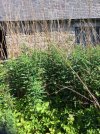HelloWeeds! Been having a go at making some of that very common one specific to the lineside....'Rosebay Willowherb'. Again taking advice from Gordon Gravett's manual, haven't got it 100%, for starters the colouring extends too far down to the base, but I don't think this is too bad for a first attempt.View attachment 188724View attachment 188725View attachment 188726
I am, unfortunately, very familiar with rosebay willow herb as it is a rampant weed along roadsides and field edges all around where we live. It continuously seeks to invade the garden.
Although it readily spreads by seed, the plant has thick creeping underground stems. So it generally forms dense clumps rather than occurring as isolated single stems. Often it is almost a monoculture as the leafy stems form a closed canopy that excludes most/all lower growing plants. Picture below taken this morning:

(The bright green low-growing plant in the foreground is ground elder).
A couple of obvious features. The dead stems (from last year — it’s a perennial) are very persistent so present right through the following season. Note their height and the portion at the top where the flowers were. The density of the canopy of this year’s growth is also clear. The new stems are still less than half their final height.
Plants in a poor soil, as in your yard, might not be as prolific as these, so significantly shorter. But a clumped distribution of stems and inclusion of the dead stems from previous years would improve the realism of the representation. Also, flowers at the top only (late summer) or fluffy seeds (autumn) but a leafy stem.

